By Jeffrey A. Rendall, Photos by Jeffrey A. Rendall
PALM DESERT, CA – The late Ted Robinson’s golf design philosophy was pretty direct: “The golfer attacks, the designer defends. Such is the adversarial relationship that defines the creation of a golf course.”
At first glance, unless you’re playing in a tournament, you probably wouldn’t consider golf an adversarial game – and we’re not talking about that contentious $2 Nassau that your group scratches over every week. Golf’s a game where you’re supposed to be one with the elements – the topography and hazards of the course itself, and the changing atmospheric conditions on the day you play.
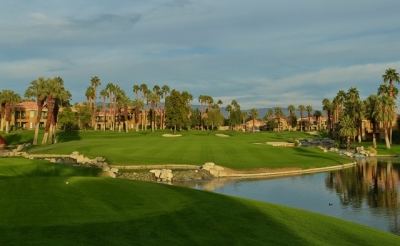 |
| Water guards the entire right side of the par four 14th hole. Bail out too far left and you'll have a real difficult second shot. |
It’s not meant to be adversarial. Golf’s tough enough as it is.
However, playing Robinson’s Valley Course at the Marriott Desert Springs in Palm Desert, California, you’ll get an idea of what Robinson was talking about. Not because you’re being annoyed; not because you’re dueling an adversary, and not because you’re feeling a negative vibe.
It’s because you’re challenging a balanced, creatively thought-out resort golf course -- and ‘fighting’ the distractions all around to focus on the game, while enjoying the tranquil golf atmosphere that Robinson literally molded out of nothing. For those familiar with the California low desert, you’ll recall a limitless flat desert landscape surrounded on two sides by stunning mountain vistas.
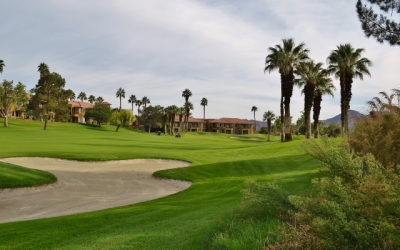 |
| Do not try to cut off too much of the dogleg right, par four 4th hole or you could end up in trouble. |
In between is a playground of resorts, gated housing communities and golf courses. Many a time flying over the area, it’s easy to pinpoint greater Palm Springs because just about every corner has a golf course.
Robinson continues, and explains what he meant by ‘adversarial relationship’: “At one extreme, it’s easy to create a golf course where few people would ever break a hundred. At the other, a course too easily defended quickly results in loss of interest. The overriding objective of good course design is a balance between the two extremes, creating an effective and rewarding experience for all levels of golfers.”
Again, he’s met that objective on the Valley Course. A year younger than its sibling the Palm Course, the Valley opened in 1988, and winds in and around the Marriott Desert Springs’ Villas. The Palm Course primarily circles the hotel, so there’re some differences in the sights you’ll notice immediately.
 |
| The tee shot on the par four 18th hole provides a lot of room -- but you'll still want to place it on the right side, to give you the best angle for your approach shot. |
Almost all California desert golf courses have real estate, and because of the vacation condos, the Valley Course feels a lot more ‘residential’ than the Palm.
According to Director of Golf John Faulk, the differences don’t stop with what you see when you’re playing: “A lot of people seem to think the only difference between the Valley and Palm Courses is one goes around the hotel and the other is a little farther to the periphery. But I think, because of the ‘valleys’ on the course, there are more strategic ways to play the Valley Course. Both courses play to a similar length and rating, so it’s not how far you hit it – but really where you hit it that makes a difference.”
Faulk says the Valley Course also has more tiered greens, so you want to make sure you’re on the right level when you’re clubbing into the putting surfaces. We typically play the course right around Thanksgiving time, so the greens are just maturing with their winter blend – and putt rather slow. That makes it even more of a necessity to place your ball on the correct plane.
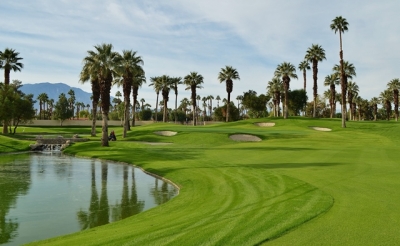 |
| Looking from the fairway of the par four 5th hole -- you can see the beautiful mountains in the distance. |
In order to achieve that perfect balance of golf course versus the golfer, each hole, each shot should challenge the player – but also provide safer options for less accomplished competitors. And when you’ve got a desert environment, the architect’s job is even more difficult to create something memorable and interesting.
Robinson spoke eloquently about what he’s up against when designing on arid land: “Flat as a mountain lake on a windless day -- most desert sites always seem to start out that way. In some respects, a blank featureless canvas is an advantage, allowing the architect to mold and sculpt at will. Without the natural variation that nature provides, however, creating diversity and movement over eighteen holes can be a challenge.”
“One solution is to undulate the contours creating high and low points that may vary as much as ten or twenty feet on a single hole,” Robinson said.
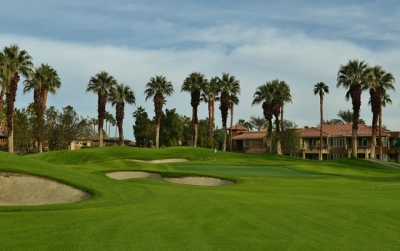 |
| Near the green of the par five 10th hole. Plenty of room, reasonable challenge. Resort golf at its friendliest, and finest. |
There lies the secret of the Valley Course. Though you’ll see from the surrounding area that there wasn’t a whole lot of height variation in the land, Robinson’s group created undulations where there weren’t any. A lot ‘hillier’ than the Palm Course, you’ll never mistake the Valley layout for a member of the mountain golf society, but there’s enough change to add to the flavor of the course.
One similarity to the Palm Course is the amount of water on the layout. Robinson was known as the ‘King of Waterscapes,’ and he certainly didn’t spare the rock when working on the Marriott Desert Springs’ second course, either.
“We’re pretty well known for pioneering the integration of waterscapes into golf course design,” Robinson remarked proudly. “One of the most rewarding comments we often hear about courses like those at the Marriott is ‘I can’t believe I’m really in the desert.’”
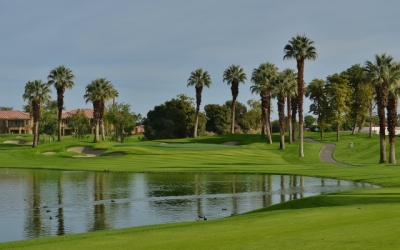 |
| At 222-yards, the par three 6th hole is the Valley Course's longest par three. Add in the water in front, and it looks even longer. |
Only someone with Robinson’s talent could make water look right at home in the desert, but there’re also the palm trees, swimming pools and vacation villas to help point you in the right direction. You probably won’t be wondering if you’re in the desert, but you’ll also be thinking that this could be paradise. Not a bad place to spend a day, even if it does reach 120 degrees during the summer, occasionally.
If there is a drawback, one thing you’ll get with nearly all the best desert golf courses is sticker shock. We’re not saying there isn’t value involved, but when you come here, be prepared to lay out some cash. The Marriott Desert Springs is neither the least nor most expensive in the Palm Springs area, but unless you’re playing in the heat of the summer (when there are some fantastic bargains), the privilege comes fairly dearly.
The conditions help to ease the pain, however. As mentioned earlier, we typically play just as the courses are coming back from fall overseed. But once the grow-in is complete, you won’t find better playing surfaces anywhere. In other words, you’ll pay the fee but what you see is a far cry from the bleak gray surroundings back home.
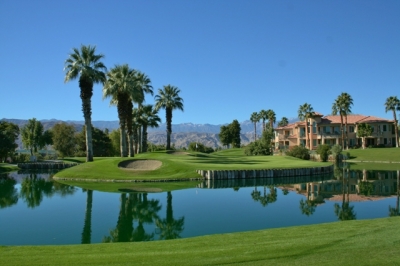 |
| The green for the par four 16th hole is on an island, along with palm trees and bunkers. Pull up a chair and order a tropical drink, and you're set. |
And if you’re fortunate enough to stay in the Marriott villas or at the hotel, you certainly won’t want for attention or comfort. The Marriott Spa is first-rate, complete with workout facilities and all the treatments you’d desire – and the restaurants are equally well done.
As previously alluded to, the Valley Course presents resort golf at its finest. The fairways are exceedingly generous, and the hollowing out of the playing areas provides further protection from the lost-ball bug – and also the residents bordering the fairway. Faulk says they get the occasional broken window in the villas, but it takes a pretty foul ball to get there.
Because of the undulating nature of the course, you’ll also see some awkward lies. The rough is cut to a manageable level, but thick enough to be a penalty if you’re off-line. And the mounding around the greens will test short pitches and chips to try and save pars.
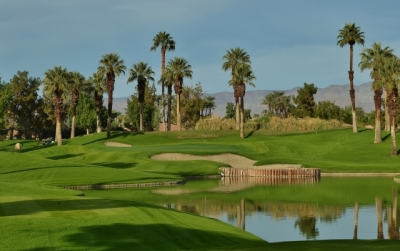 |
| The greenside bunkers on the par three 8th hole are large and deep. All in all, quite a challenge to make par if you miss off the tee. |
No tricks, no gimmicks, the Valley Course is just a pleasant ride through a desert oasis.
Hole highlights include the seventh hole, a short, 320-yard par four. On the scorecard you’re thinking ‘birdie hole,’ but it’ll depend on your ability to place it in the fairway, then wedge it in close to this tricky green. You can hit a longer club from the tee, but it’s safer to go with a long-iron and just leave it at the proper distance. Watch out for a front pin position too.
We also enjoyed the eighth hole, a 185-yard par three. From the tee, you’re hitting over water to a slightly elevated green. This hole’s a good example of the need to avoid the trouble on the Valley Course, because the bunkers are large and deep around the green. Distance won’t kill you here, but if you miss, you’ll probably have a hard time making par.
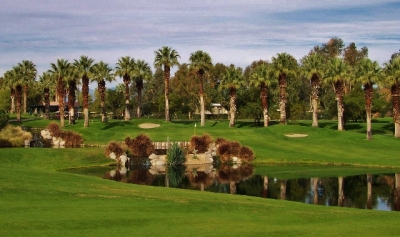 |
| There's a dramatic challenge waiting for you on the 18th hole. It'll take a solid shot to avoid the trouble and walk off with good thoughts. |
On the back side, number fourteen is one of the Valley’s signature holes. 415-yards and a dogleg right, you’re tempted to try and cut distance off the leg – but it’s guarded all down the right side by water. Very picturesque, and can be dangerous if misplayed. If you choose to take the safe route, it’s a tough second shot to work in to this well protected green.
The sixteenth hole is another nice risk-reward par four. Just a lay-up off the tee, the approach is to an island with a small putting surface. Be sure to be on the right level here, or you could easily three-putt.
The finishing hole on the Palm Course is a good one, and so is its counterpart on the Valley Course (403-yard par four). The second shot must fly a pond, so if you have any hope to go at the green in regulation, you’ve got to be in the fairway off the tee. There is some bailout room to the right, but that’ll make a final par a long-shot at best.
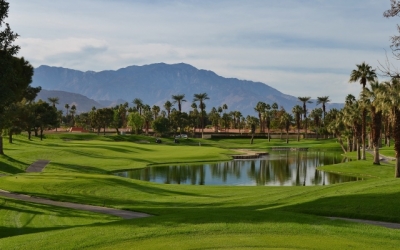 |
| Off the tee of the 7th hole, the mountains look like they're rising out of the horizon. |
Summing up, the Marriott Desert Springs’ Valley Course is a pleasant resort course that adequately balances that ‘adversarial relationship’ that Robinson was talking about in course design. It’s not too tough, and it’s not too easy. The service is excellent, the pace moved along well and there’s plenty to do after your round.
Who would’ve thought you’d need to come to the desert to find such a balance?
Details:
The Valley Course at the Marriott Desert Springs Resort and Spa
Director of Golf: John Faulk, PGA
Course Architect: Ted Robinson
Phone: (760) 341-2211; (760) 341-1756
Tees/Yardage/Slope/Rating
Black 6627 127/71.5
Blue 6323 125/70.1
White 6023 122/68.7 74.5/126 (W)
Red 5262 118
Rates:
Check the website for current rates, including some excellent package deals.
| Related Links | Comments on this article? | |
|
Maryland National Golf Club Hollow Creek Golf Club Rocky Gap Resort PB Dye Golf Club in Ijamsville Whiskey Creek Golf Club |
E-mail Jeff Rendall, Editor: jrendall@golftheunitedstates.com |











